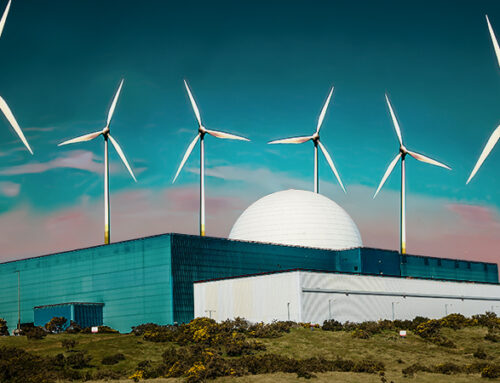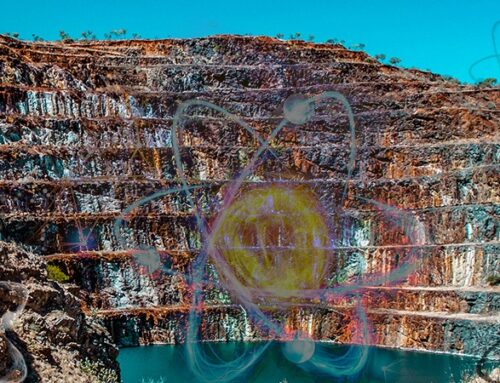Nuclear power is back in the news in the UK, with reports that the Government is provide support to the new nuclear plant being developed at Wylfa Newydd in Angelsey, Wales by Horizon Nuclear Power, a subsidiary of Hitachi. According to Richard Harrington, the Under Secretary of State for Business and Industry, several funding options are under consideration, including a direct equity stake in the project, a sovereign guarantee on loans and a partnership between the UK and Japanese governments.
“From the government’s point of view, it’s about taking some risk for a lower price for the consumer. That’s what the government is looking at and what the Hitachi board were discussing — whether the British government’s position was suitable for them to take it to the next stage,”
– Richard Harrington, Under Secretary of State for Business and Industry
According to Harrington, the funding model will be different from Hinkley Point C (“HPC”), which secured a CfD strike price of £92.50 /MWh, more than double current market prices, for 35 years. EDF is paying all the construction other costs at HPC until it begins generating power, meaning almost all of the development risk sits with the developer. In the case of Hitachi, the government plans to take more of the risk, potentially bringing other private investors in at a later date.
This marks a reversal of a previous policy not to commit public funds to the construction of new nuclear reactors, and will allow the project to benefit from the Government’s ability to access cheap debt funding. On the flip side, this will also expose taxpayers to potential steep costs and higher risks.
“This is really important. We have been campaigning for new nuclear power stations to be part of the UK’s energy mix; security of supply is very important to the country. We have long advocated for the state to use its balance sheet to get critical infrastructure projects off the ground. This is sensible from the point of view of energy supply and energy security,”
– Adam Marshall, chief executive of the British Chambers of Commerce
Hitachi is also seeking a guarantee on the power price it will receive through the Contracts for Difference (“CfD”) mechanism, although the latest reports are that this will be around £15 /MWh lower than for HPC, since the risk profile will be significantly different.
Construction could start next year with the plant beginning operation in the mid-2020s.
EPR progress update
Hinkley Point C is a European Pressurised Water Reactor (“PWR”), a technology that has been beset by problems since EDF first began to develop it more than a decade ago. In addition to HPC, there are currently four other EPRs under construction worldwide: the flagship plant at Flamanville in France, another at Olkiluoto in Finland and two reactors at Taishan in China.

Flamanville testing underway
Cold functional tests began at Flamanville on 18 December and were completed on 6 January. Testing of the reactor building to confirm its airtightness was completed on 3 April, and hot functional tests are due to start in July.
Cold functional tests confirm whether components and systems important to safety are properly installed and ready to operate in cold conditions. The main purpose of those tests is to verify the leak-tightness of the primary circuit.
Hot functional tests ensure the proper functioning of coolant circuits and nuclear safety systems before fuel is loaded. They are the first tests at plant-level where the reactor and turbine plant are operated as a whole – water temperature and pressure in the primary circuit are gradually increased to operational levels, and during the final phase of testing the steam turbine is driven for the first time.
Fuel loading at the Flamanville EPR is scheduled to begin in the fourth quarter of this year, and the plant is expected to come online in by the end of next year, although it remains to be seen whether recent problems with secondary coolant system welds will result in further delays. Construction began in 2007 with a budget of €3.5 billion, however the cost is now estimated at €10.5 billion.
Olkilouto likely to open a decade late in May 2019
According to power consortium Teollisuuden Voima Oyj (“TVO”) the new reactor at Olkiluoto, which was expected to be the first EPR to open globally, is on track to commence commercial production in May 2019. Cold functional testing was completed last June and TVO announced in May that hot functional tests have been completed and preparations have started for loading fuel into the core of the reactor ahead of its start-up later this year.
In March, TVO agreed a settlement with Areva and Siemens in a long-running dispute over cost overruns and delays to the project, under which Areva and Siemens will pay compensation of €450 million to TVO.
Construction on Olkiluoto began in 2005 under a turnkey contract, with completion originally scheduled for 2009 at an estimated cost of €3.2 billion, however the project is almost a decade late and the total investment is now estimated at around €5.5 billion. Should the plant not be completed by the end of 2019, Areva and Siemens will pay a penalty to TVO with the amount depending on the extent of the delay, but limited to €400 million.
Fuel loading will begin following a safety assessment by the Radiation and Nuclear Safety Authority, and a decision by the Finnish government to issue an operating licence.
TVO said it anticipates loading the 241 fuel assemblies into the reactor in the autumn – 128 tonnes of fuel has already been delivered to the site in southwest Finland.
Fuel loading at Taishan
The first EPR to begin commercial operations is likely to be the Taishan plant in China. Developer China General Nuclear Power (“CGN”) has announced that it has begun loading fuel at the reactor. Loading takes several months, and, as the plant has received its permits from the National Nuclear Safety Administration, full operation is expected before the end of the year.

Construction on the Taishan project, which is a joint venture between CGN, which owns 70% and EDF which holds the remaining 30%, began in 2009 with the first of two units originally scheduled to be completed in 2013.
Late last year there were reports that the deaerator, which removes oxygen and other gases from boiler feedwater circuits, cracked during performance testing due to defective welding. Defects in the welds had apparently been flagged by an engineer at manufacturer Harbin Boiler as early as 2012. The unit has since been replaced.
Regulators in France and the UK criticise EDF’s quality control
Flamanville has been beset with serious construction problems, most recently with the discovery in March of quality deviations in some of the welds in the main secondary system of the reactor. In a pressurised water reactor, steam generators transfer reactor core heat from the primary coolant loop into a secondary loop – a closed system in which steam produced in the steam generator is conducted towards the turbine where it is used to generate electricity.
EDF said the first quality deviation in the welding was detected on 21 March during the initial comprehensive inspection, a regulatory requirement prior to the reactor starting up, despite having been initially signed off by contractors. 38 out of 66 weldings were found to be sub-standard.
French nuclear regulator, ASN has carried out an inspection following EDF’s announcement and found organisational failures in the construction process:
“The inspection revealed that the organisation and working conditions during the manufacturing completion checks were on the whole prejudicial to the quality of the checks. Inappropriate surveillance of this work by EDF and Framatome [formerly Areva] also failed to identify and remedy the difficulties being experienced by the operators. Certain flaws are still being investigated, in order to understand why they were not detected during the manufacturing completion inspections.”
The inspectors concluded that EDF’s procedures for checking the welds are now appropriate, but considers that EDF should extend these checks to other systems. ASN will issue a position statement on the corrective measures proposed by EDF after the completion of the tests.
 The ASN’s findings have been echoed by the British nuclear regulator, which has identified several shortcomings in the way EDF is managing the supply chain in the HPC project. Although not in themselves serious enough raise regulatory issues, they “may indicate a broader deficiency” in the way the company is run, according to Mark Foy, chief inspector at the Office for Nuclear Regulation (“ONR”).
The ASN’s findings have been echoed by the British nuclear regulator, which has identified several shortcomings in the way EDF is managing the supply chain in the HPC project. Although not in themselves serious enough raise regulatory issues, they “may indicate a broader deficiency” in the way the company is run, according to Mark Foy, chief inspector at the Office for Nuclear Regulation (“ONR”).
A team of 11 inspectors visited the Hinkley site in October and November last year, as well as EDF facilities in Bristol and Paris, and a French factory making parts for the plant. The visits were triggered by the regulator’s concerns that EDF did not have sufficient oversight of the Creusot nuclear forge in France, where records have been found to be falsified, concealing excess levels of carbon in the steel pressure vessel components. Although these issues did not impact any of EDFs reactors in the UK, problems were found in many of the French reactors which had to be taken offline in late 2016/early 2017 for testing.
The ONR judged that EDF’s supply chain management is improving but remains below standard in some areas. The ONR was particularly concerned that EDF’s internal oversight and governance had not identified the shortcomings at the forge, and that a lack of resources had meant EDF did not undertake an internal audit of its quality control processes during 2017.
EDF is maintaining that HPC will come online in 2025 as planned, despite concerns that full operation may be pushed back to 2027.
Yes to new nuclear but no to first tidal lagoon scheme
An agreement to support the new nuclear project at Wylfa Newydd will be positive. The UK needs more baseload power supplies, and nuclear is a long-term solution that is also consistent with de-carbonisation goals. The technology choice here is also a good one – Advanced Boiling Water Reactors are currently the only third generation nuclear reactors in operation anywhere in the world, so the delivery risks are lower than with HPC, and the technology is arguably superior to the EPR.
The Financial Times is reporting today that the Government is set to reject the £1.3 billion Swansea Bay tidal scheme, and will likely make the announcement at the same time as the Wylfa Newydd announcement since both schemes are located in Wales. This will be another good decision – the Tidal Lagoon project would have been roughly twice as expensive as HPC, and required the Government to provide support for 90 years, versus 35 years for HPC.
The NAO was deeply critical of the HPC decision, describing it as marginal at best. With Wylfa Newydd, the Government has the opportunity to secure much needed additional baseload capacity on better terms and at lower risk, given the greater maturity of the technology. Choosing not to support an untested and expensive new source of intermittent generation is also positive for the security of the energy system and will deliver better value to consumers.






There is of course nothing novel about the Swansea Bay project except the length of its retaining breakwater relative to the area enclosed – which makes it uneconomic. Otherwise, it is a copy of La Rance, which has been operating since the 1960s – but that only required 750m of barrage (much of which was taken up with the power station and its associated sluices, and which carries a road over the top between St Malo and Dinard, saving quite some miles of driving) If it is considered an innovation not to dam a river estuary, then look to Lake Sihwa in Korea, which got its barrage for free when the project to create a freshwater lake went wrong.
I think I shall miss the Swansea Bay project if it is indeed cancelled – I have spent quite a bit of time digging out information on tidal barrages/lagoons and understanding the engineering details and the impacts on tides and water levels, and thinking about how they might abuse a high price CFD (basically by using market price electricity to pump extra volumes in and out close to high/low tide, and using that to generate more power sold at CFD price).
Congratulations on several excellent articles in recent weeks. I really must stop by your site more often.
I actually think it’s a shame – tidal energy feels like it should work. I’ve mentioned before living by the Thames and seeing the 8+ metre tidal variation twice a day, and the volumes of water are huge – the problem is how to capture it economically. Swansea Bay had some great ideas, combining with leisure and tourism, but it is simply far too expensive. (And yes, there is scope for abuse of the CfD scheme…)
Thanks for your comments and feedback – my site stats have jumped up recently so I guess I must be doing something right!